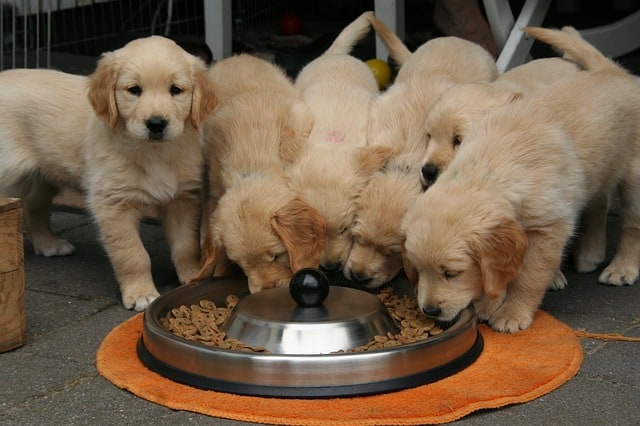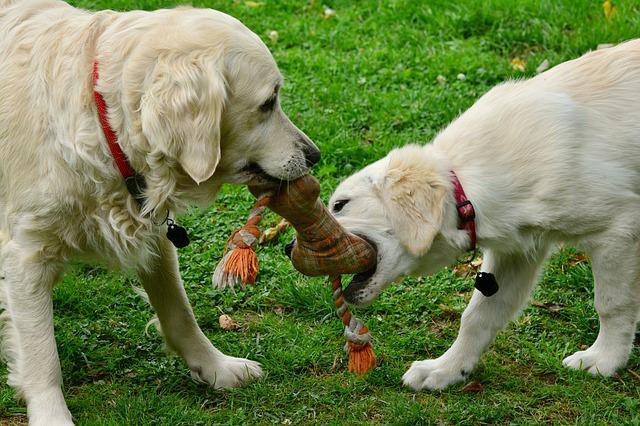The Golden retriever is a beautiful dog with golden colouring. It's a hunting dog, retriever, scent hound, and an excellent family dog all in one. He gets along with any pet, even a guinea pig, and there shouldn't be an ounce of aggression in him.
Contents
He is excellent as a family companion, however, for him to rest peacefully on the couch and act as the house's mascot - he needs activities.
Goldens are excellent retrievers, so the dummy is a sport created for retrievers. He is a working dog, created to work in water, for example, to fetch arrows. Fortunately, you can meet his needs much more quickly, through active learning of tricks, obedience training, and tracking.
Golden retriever coat stages
Stage 1

At 3 months old, most Golden puppies begin to shed feathers in their short, fluffy puppy coat. If the puppy's parents later grew an adult coat, it is more likely to do so.
has the best source of information about your puppy's heritage. You can ask the breeder to meet the puppy's parents and find out at what age they had the adult coat.
Stage 2

When the puppy is about 3 months old, he will begin to see long hairs growing on his tail. This stage indicates the beginning of blending. Golden Retrievers have feathers on their tail, belly and legs. The dog's tail is the starting point for the growth of the adult coat.
The rest of the adult hair will grow all over his body. The recent hair growth will be slightly darker than the formerly light puppy coat.
The Golden Retriever puppy differs from other breeds in that it does not shed its puppy fur. Instead, the puppy fur is repelled by a newer, more long, outer coat that grows. The complete transition takes 18 months.
Golden retriever appearance

You need to know something before you have a golden retriever living under your roof - the breed description. This dog has a harmonious appearance that is perfectly finished with a longer coat. The head is nicely sculptured, without jowls, with a well-defined foot and a relatively long muzzle. The balanced body ends in a tail carried flush with the topline. The limbs are strong, and muscular, giving the Golden Retriever an energetic, powerful gait without raising the front paws too high.
The golden dog has longer, smooth or wavy hair finished with feathers. Importantly, underneath the coat, a dense undercoat protects the skin from water. The acceptable coat colour is golden or cream. There may be a small white mark on the forecast. However, the coat must not be too dark - red or mahogany.
When it comes to Golden Retriever dogs, the breed description also applies to size. Males are slightly larger than bitches, a common trait in quadrupeds. At the withers, their size is 56-61 cm, and bitches - 51-56 cm. The weight of males fluctuates around 28 kg and females - 27 kg.
Goldens are classified as medium-sized breeds. Their standard weight can range from 25-45 kg, with males reaching 56 to 61 cm at the withers and females from 51 to 56 cm. They have a proportional and quite muscular body structure. This is a sizable but gentle breed known for its warm nature. Golden retrievers are extremely friendly and sociable, they give equal sympathy to basically everyone - even burglars. Therefore, they certainly can not be considered guard dogs.
They are patient and very understanding - great dogs for families with children. They are usually easy to raise. They get attached, love company, and usually get along well with other animals. Quite often they are used in dog therapy, sometimes they work as tracking or rescue dogs. They can detect drugs or gas leaks. They can also be trained to help people with disabilities.
A golden retriever is definitely not a couch dog. You need to take him out for long walks to "run around". He loves all physical activities, including swimming. He is remarkably resilient. Originally, it was a hunting dog, so it happens that it brings various "prey" in its mouth.
Golden retrievers have gorgeous fur, which is a dog decoration. Of course, the pet looks great if its coat is neat, shiny and clean. Dirt, tangles, bits of twigs, or food entangled in the hair take away a lot of the charm and are unpleasant for the pet itself.
They can pinch, tangle and snag on everything. In case of exceptional lack of care, fur can start to moss and felt, which looks really awful and there is no way to do anything with such a mess of hair - only cut it off. So let's take care of our pet's fur so that it remains a natural decoration and we can be proud of it. What is the best way to take care of a golden retriever's coat?
What is the coat of a golden retriever?

Golden retrievers have a coat that is either smooth or somewhat wavy. The hair is quite long and reaches its largest size on parts of the body such as the chest, belly, thighs, tail, and front legs (exactly their backside). These dogs have an undercoat and it is waterproof. Long hair is a beautiful look but has many problems because it tangles easily.
It's also not very resistant to dirt, especially because golden retrievers in a classic coat don't have protective colours (it means that after jumping in the mud it will be obvious). Dogs of this breed undergo intensive moulting in spring and autumn, which should be responded to with more frequent and intensive brushing. You should also consider giving your dog a dietary supplement to strengthen growing hair.
Tools for golden retriever coat care

Since the coat of this breed of dog is both delicate and quite long, we need several fur care tools for different stages of combing. All products should be bought in a good pet store e.g. Telekarma. pl. Do not use human tools! They are not suitable; for example, the same comb as our dog is extremely unhygienic.
So what do we need and what should we equip ourselves with? First, we need a poodle brush - it is perfect for smoothing the hair without tugging it too much. Secondly, a metal comb is irreplaceable when attacking tangles of all kinds.
Thirdly, one of the following tools will come in handy, depending on what your pet's hair is like and what effect you want to achieve with trimming and shaping the different parts: a pair of degloving scissors, a trimmer, a razor or a trimmer rake. What are these tools used for? Primarily to shape the fur on the neck, ears, paws, bristles and tail.
The combing itself should always be done on a dry coat. We make gentle, sweeping motions, starting with the head and ending with the tail. Do not tug or pull the fur. First, we deal with tangles with a comb, then we smooth the whole with a brush.
Alternatively, we can apply conditioner to the coat during bathing and then use a metal brush to remove any tangles and tangled parts of the hair. After a thorough combing, if the dog is preparing for a show, we can spray over the coat anti-static liquid, so that it will not electrify.
Cosmetics for golden retriever coat care

What is the best shampoo for our Golden? A golden retriever should be bathed (if it gets very dirty, of course, this should be done more often). Our dog needs special cosmetics, dedicated to shaggy dogs, not humans! Using our products will disturb the pH of his delicate skin, and may cause rashes, hair loss, itching and dandruff. Of course, for long-haired pets, a hypoallergenic one will also be very good, for exceptional sensitivities.
Before taking part in a show it's worth using a special shampoo to increase the coat's volume and use a smoothing spray. Remember that the shampoo should be rinsed thoroughly and be careful not to get into the nose, eyes or ears of the pet (ears of the dog should be cleaned and dried after each bath, because due to their hanging shape it is difficult to drain water from them, and in warmth and moisture fungi can develop).
During washing, we can also apply conditioner or lotion for a few moments to make fur smooth and shiny. Then take a soft towel and squeeze out excess water (do not rub or rub too hard). A hairdryer will also come in handy - set a slightly warm stream of air and gently, part by part, dry the coat.
Don't exaggerate the amount of shampoo, as the hair will stick together and fall out, making it look greasy, which definitely won't add to the dog's charm. Let's also remember about regular trimming tufts of fur from between paw pads. To do this, let's use scissors with a rounded end.
Grooming

The golden retriever has a characteristic, long, dense coat of a golden colour, but does not moult excessively. The dog needs to be brushed 1 or 2 times a week, except during increased hair loss (spring and autumn), when it may be necessary even daily. In addition, the dog's claws need to be trimmed regularly - otherwise, they can cause discomfort and pain.
It is also necessary to cut the hair from between the pads. However, frequent baths are not advisable, except for recreational ones in open water. Golden retrievers should only be bathed when they are simply dirty. After each contact with water, his ears should be thoroughly cleaned to avoid the development of ringworm.




